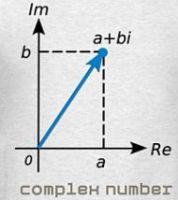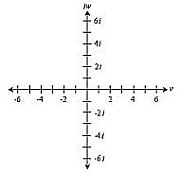 The Complex Number Field: Let F = R, and let f(x) = (x2 + 1), which is well known to have no zeros in R, and thus is irreducible over R. Then <x2 + 1> is a maximal ideal in R[x], so R[x]/<x2 + 1> is a field. Identifying r in R with r + <x2 + 1>, we can view R as a subfield of E = R[x]/<x2 + 1>. Let
The Complex Number Field: Let F = R, and let f(x) = (x2 + 1), which is well known to have no zeros in R, and thus is irreducible over R. Then <x2 + 1> is a maximal ideal in R[x], so R[x]/<x2 + 1> is a field. Identifying r in R with r + <x2 + 1>, we can view R as a subfield of E = R[x]/<x2 + 1>. Let
= (x2 + 1) + <x2 + 1> = 0.
Thus α is a zero of (x2 + 1) in R[x]/<x2 + 1>. We can view R[x]/<x2 + 1> as an extension of R. Then R(α) = R[x]/<x2 + 1> and consists of all elements of the form a + bα for a, b in R. But since α2 + 1 = 0, we see that α plays the role of i in C, and a + bα plays the role of (a + bi) in C. Therefore R(α) is isomorphic to C.
We're identifying <x2 + 1> with zero through the factor ring where the kernel is the zero element, analogous to a factor group, the role of normal subgroup being played by the ideal. The polynomial (x2 + 1) has no solution in R, the Real Numbers, but it does in C, the Complex Numbers -- the solution being the square root of minus one, i = √-1.
We're basically extending the field R to C; that is, in the act of deflating, we expand. The external appearance of R[x] shrinks and at the same instant its internal configuration embeds itself in the newly defined algebraic structure, infusing its integral domain structure into that of the field -- R[x]/<x2 + 1>.
This is very similar to how the field of rational numbers, Q, includes the integral domain of integers, Z. Z before the transition is all of the universe, after, it resides inside the more complex Q. Imagine the integers spread out on a line, suddenly the formerly blank space between pairs is filled with an infinite number of fractions -- quotients of integers. By virtue of these fractions, the non-zero integers take on the new role of units. Z shrinks in relative size, yet grows, through sub-divisions, to a vast sea of multi-dimensional relationships and interconnections.
Here's what's happening: The axiom we needed to jump from an integral domain to a field was the existence of a multiplicative inverse for each non-zero polynomial -- f(x) + <p(x)> -- in our quotient ring. Those are our units. A proof that they exist can be found at the link on Quotient Rings below. That gives us the added internal structure of an abelian multiplicative group and hence, a field. The symmetry of connections after collapse increases by a whole new order. Topologically, a refinement has been made.
If you're interested in understanding how Quotient Rings work, what constitutes a coset, etcetera, check out: Quotient Rings | PDF File - Professor Bruce Ikenaga and Quotient Rings of Polynomial Rings.
Here's the beauty and magic of this. Regardless of whether or not you understand the theory, the math, what is going on is quite remarkable. We're creating an extension of an integral domain to a field for purposes of solving an irreducible polynomial, one that's unsolvable in the environment restricted to the real numbers. In the world of algebraic hierarchy, a field is one level above an integral domain in structural identity and therefore in complexity, similar to the difference in atom arrangements between liquid water and ice crystals. So, we're generating a more complex structure by superimposing a conditional symmetry on the parent structure through the process of factoring. A transformation to a new species occurs, one whose interconnections are far more intricate.
By identifying the irreducble polynomial with the zero element of the factor ring, we map all polynomials of the parent ring that contain the irreducble as a factor to the kernel [the maximal ideal], the zero element of the factor ring, our manufactured field. All other non-zero polynomials [units] are considered congruent if they differ by a multiple of the zero-class -- [x2 + 1] -- and are thereby grouped into cosets of equivalence classes.
 By placing boundaries, setting initial conditions, on something infinite and incomprehensible, we make it comprehensible. To reiterate, by partitioning the ring of polynomials with real number coefficients -- R[x] -- into distinct, disjoint cosets modulo <x2 + 1> we are essentially collapsing R[x] by a subring containing all polynomials that share (x2 + 1) as a factor -- (x2 + 1)•f(x) for all polynomials f(x) in R[x]. Simultaneously we are increasing the complexity of R[x]. We're going from a one-dimensional system -- the Real Numbers -- to a two-dimensional system -- the Complex Numbers.
By placing boundaries, setting initial conditions, on something infinite and incomprehensible, we make it comprehensible. To reiterate, by partitioning the ring of polynomials with real number coefficients -- R[x] -- into distinct, disjoint cosets modulo <x2 + 1> we are essentially collapsing R[x] by a subring containing all polynomials that share (x2 + 1) as a factor -- (x2 + 1)•f(x) for all polynomials f(x) in R[x]. Simultaneously we are increasing the complexity of R[x]. We're going from a one-dimensional system -- the Real Numbers -- to a two-dimensional system -- the Complex Numbers.
To paraphrase from above: Then R(i) = R[x]/<x2 + 1> and consists of all elements of the form a + bi for a, b in R. The extension creates the vector space of two-dimensions. From this we see that the Complex Number Field is isomorphic to the Euclidean Plane. One axis for the Reals and the other for "i", the imaginary number -- √-1. Any point in the plane-space can thus be mapped by a complex number.
By factoring the parent ring with the stamp of the irreducible polynomial, we force (x2 + 1) to equal zero and thereby introduce the number √-1. By increasing the complexity of the integral domain structure, we generate another dimension in the number field. R thus becomes a subfield component of C; that is to say, <R, √-1> is an extension over the fixed field R.
The mathematics of evolution.
For p(x) = (x2 + 1):
The real line is the function line, each point, a function or polynomial, f(x). To it is added a function-multiple of i = p(x). The linear combination, f(x) + <p(x)>, maps isomorphically to a + bi on the complex plane.
The field of polynomials, R[x]/<p(x)> equal to R(i) ≈ C can be mapped to the complex plane by cosines and sines.
The exponential function eiθ equals the sum of the power series expansions for cos(θ) and i sin(θ).
We get: ei f(x) = cos(f(x)) + i sin(f(x))
Replacing θ with f(x) in R[x] maps them isomorphically to the complex plane. Each non-zero number on the Real line must equal, or is isomorphic to, a function in R[x].
The zero equivalence class, [p(x)], is orthogonal to the function line, and is therefore at 90 degrees, or π/2 radians. Therefore, for x = 0, the cosine of f(x) + 0[p(x)] equals one, and the sine equals zero. And for a nonzero multiple of [p(x)], the sine [p(x)], or the i axis in the complex plane, is equal to one (1) and the cosine, zero.
